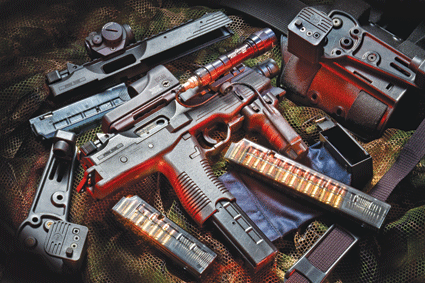While it’s not quite fair to say that “military handgun” is an oxymoron, it’s undeniable that a pistol in combat is a last ditch resort. A hand-held weapon is not only less powerful than even the most bland rifle caliber, but also it requires considerably more skill to shoot effectively. Even in expert hands, a pistol is hardly effective beyond 50 yards.
Pistols are valuable, make no mistake. Military handguns can make for a nifty badge of office—Patton cut a mean profile with his mismatched pair of revolvers—and a pistol is certainly better than a shovel if your primary weapon goes down in a fight.
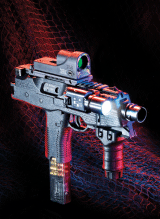 But other than a few extreme exceptions, like a BlackHawk Down scenario when you’re surrounded by an enemy mob and you run out of ammo, the martial role of a pistol is largely moot. As more than one wise-acre has observed: “I carry a pistol so I can fight my way to my rifle.”
But other than a few extreme exceptions, like a BlackHawk Down scenario when you’re surrounded by an enemy mob and you run out of ammo, the martial role of a pistol is largely moot. As more than one wise-acre has observed: “I carry a pistol so I can fight my way to my rifle.”
Advertisement — Continue Reading Below
The brass knows this. The problem is that a handgun is an easy fix for providing non-combat personnel, like truck drivers, radar operators and other rear echelon troops, with a small, easy-to-carry weapon. The U.S. Army and other armed forces have toyed for many years with a “future weapon” concept of a step up from the handgun. They call it a Personal Defense Weapon (PDW) and several notable designs have been trotted out.
The PDW idea is not new. The earliest such design, going back to before World War I, was the Broomhandle Mauser, fitted with a detachable shoulder stock-slash-holster. The M1 Carbine of World War II vintage, while not a PDW, was an attempt to equip non-frontline troops with a small weapon. More recent PDW designs include FN’s P90, HK’s MP5K, the Israeli Mini Uzi and our subject at hand (sort of), Steyr’s TMP.
Switzerland Via Austria
Steyr Daimler Pugh, the Austrian conglomerate that builds everything from tanks to bayonets, set about developing a PDW to satisfy what appeared to be an increasing interest from the Austrian army in just such a weapon. Steyr had—and has—a remarkable knack for thinking outside the weapons design box. Exhibit A is their AUG rifle, a bullpup with an integral optic in a carrying handle that was nonetheless innovative despite its lack of sales success.
Exhibit B: Steyr was the first company to produce a polymer handgun (no, it wasn’t Glock) and the first to make a polymer stocked rifle, the SSG.
Advertisement — Continue Reading Below
Exhibit C: Steyr stepped up to produce Jeff Cooper’s concept of the all-around rifle, the Scout.
One thing in common with all of these designs is—one word for you, son—plastic. The AUG was a composite rifle, the GB pistol was polymer, the SSG sported an injection molded stock. No question, Steyr knows polymer.
Composite materials are one of the real strengths of this strangely under-appreciated Austrian gunmaker and so it was natural that when their engineers set about designing a PDW, it would be made of polymer. Both the upper and lower halves of the gun are polymer, encasing a steel bolt/barrel/receiver group.
Advertisement — Continue Reading Below
The gun was called the Tactical Machine Pistol (TMP). As clever as it might have been from a design standpoint, Steyr misjudged the real-world demand for a PDW and the gun promptly followed in the footsteps of the AUG—a disappointing commercial flop. Steyr mothballed the TMP and discontinued its semi-auto commercial counterpart, the SPP.
The TMP design languished in Steyr’s attic, so to speak, until 2001 when new investors bought the Austrian manufacturer and ran an inventory of the misunderstood company’s assets. Seeing the dead horse in the attic, the decision was made to scrap the TMP. The parts and molds would be destroyed, a bookkeeping write-off taken. But, as is the case more times than not, one man’s trash turned out to be another man’s treasure.
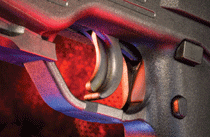 Brugger & Thomet, a Swiss manufacturer of sound suppressors, Picatinny rail forends and other tactical products, had an ongoing business relationship with Steyr and Karl Brugger, one of the owner’s, made the Austrians an offer for all the TMP drawings, parts inventory and molds.
Brugger & Thomet, a Swiss manufacturer of sound suppressors, Picatinny rail forends and other tactical products, had an ongoing business relationship with Steyr and Karl Brugger, one of the owner’s, made the Austrians an offer for all the TMP drawings, parts inventory and molds.
Advertisement — Continue Reading Below
The Austrians saw this as found money since they were going to scrap the TMP anyway, so a deal was struck in which Brugger & Thomet gained all rights to the TMP along with the parts and drawings.
TMP Becomes MP9
The Swiss company started by re-designing what they would call the MP9 for Machine Pistol 9mm to address a number of shortcomings in the original Steyr gun. In all, 19 separate design changes were made. Before looking at the “new and improved” MP9, we need to go back and see exactly what the TMP had going for it in the first place.
The TMP addressed the basic requirements for a non-frontline weapon which—and the Austrians got most of this right—included a compact, unobtrusive size-profile. The overarching goal of a PDW has been and always will be size-driven. It must be small, and Steyr’s ambitious goal was to make the TMP as close to the same size and weight as a handgun as possible.
Advertisement — Continue Reading Below
Accordingly, the TMP was made to accept a magazine in its pistol grip, like most handguns but unlike other PDW designs such as the MP5K, FN’s P90 and various miniaturized M16s. By the same reasoning, a shoulder stock was intentionally omitted.
The basic Steyr design consisted of a gun in two horizontal halves, an upper housing and a lower receiver. The lower contained the fire control mechanism while the upper housed a barrel-bolt-breech assembly, which in turn contained the recoil spring. These parts were the only steel in the gun, other than an few small connectors, disconnectors and transfer bars. The two polymer halves mated via a takedown latch similar to that of a Glock, making field stripping easy.
The TMP’s basic function is a locked breech, recoil operated, mechanism with a rotary bolt mating solidly to the breech. As the gun fires, the barrel is internally locked to the breech. Initially, the barrel moves back, still locked to the breech, under gas pressure. After a short movement, the bolt rotates clockwise as it hits a cam, which engages a slot on the side of the barrel.
Advertisement — Continue Reading Below
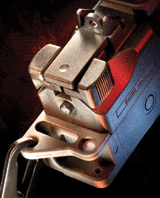 By the time the cam reaches the end of the slot, the barrel has stopped moving, however, it has rotated enough for the breech to have unlocked itself. The breech continues moving to the rear, extracting and ejecting the empty case. As it reaches its rearmost travel, the recoil spring propels the assembly forward again, stripping a fresh round from the magazine. So goes the firing cycle.
By the time the cam reaches the end of the slot, the barrel has stopped moving, however, it has rotated enough for the breech to have unlocked itself. The breech continues moving to the rear, extracting and ejecting the empty case. As it reaches its rearmost travel, the recoil spring propels the assembly forward again, stripping a fresh round from the magazine. So goes the firing cycle.
In short, the TMP is a closed-breech, selective-fire machine pistol firing with a cyclic rate of about 850 rpm.
The caliber chosen was 9mm Luger for NATO compatibility which, again, addressed the needs of rear-echelon troops for an easy to control, easy to shoot emergency weapon.
Advertisement — Continue Reading Below
One of the biggest Steyr mistakes was to equip the TMP with a selective fire trigger borrowed from the AUG, in which a half-pull results in semi-auto fire and a full-pull gives full-auto fire. If you’re thinking that it would be hard for an operator to know just how much pressure to exert on the trigger to control the rate of fire, you would be right. The AUG’s selective-pressure trigger was incorporated in the TMP.
On the plus side, the TMP was easy to control thanks to the weight of the barrel-bolt-breech assembly, coupled with the dampening effect of the polymer housing. The 2.75 pound machine pistol was a pleasure to shoot. Recoil was virtually non-existent and untrained shooters could easily control the gun in full-auto.
When Brugger & Thomet picked up the TMP off the scrapheap of firearms history, they didn’t just put it back into production, the Swiss manufacture addressed the flaws in the TMP’s design and updated the gun to reflect the current state-of-the-art.
Advertisement — Continue Reading Below
B&T’s engineers—as inventive and out-of-the-box as their Steyr counterparts, but more grounded in tactical reality—started by redesigning that problematic AUG trigger and adding a three-position, sliding safety/selector. The new gun was known as the MP9 and the trigger simply fires the gun. The sliding bar serves as a safety and selector, like most select-fire weapons.
Additionally, B&T added a drop safety onto the trigger itself, like a Glock or S&W M&P.
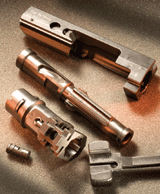 Also disagreeing with Steyr about the desirability of a shoulder stock, B&T added a folding stock that, when folded closed, serves as a forward pistol grip. A Picatinny rail was added to the top cover— the MP9 is perfect for one of the new T1 micro sights from Aimpoint— and provisions were made for an additional rail on the bottom and right side of the top cover to accommodate a vertical grip and SureFire Scout Light respectively.
Also disagreeing with Steyr about the desirability of a shoulder stock, B&T added a folding stock that, when folded closed, serves as a forward pistol grip. A Picatinny rail was added to the top cover— the MP9 is perfect for one of the new T1 micro sights from Aimpoint— and provisions were made for an additional rail on the bottom and right side of the top cover to accommodate a vertical grip and SureFire Scout Light respectively.
The gun’s Swiss foster father also added improved sights and an integral suppressor interface for their trademark product, a sound suppressor. (Ironically, as anti-gun as Europe remains, several of the countries have enlightened views on suppressors. It’s considered part of a gun owner’s responsibility to keep noise to a minimum, so you can buy suppressors over-the-counter in several countries.)
Tactical PDW Roles
There are two primary roles for a PDW in today’s tactical environment. The first is the traditional role of a weapon for non-frontline troops, a better-than-a-shovel back-up for emergencies. The second is for personal protection work which, today at least, includes both military and non-military players.
From a military standpoint, the role of a PDW has itself changed. In the 1980s, NATO planners were still working on “red menace” scenarios in which the enemy was the Soviet Union and the threat was a sudden attack that included Spetsnaz commandos dropping behind NATO lines to sabotage the rear and its supply lines. The brass assumed the Spetsnaz would be wearing body armor so a requirement for a round capable of penetrating Soviet armor was deemed mandatory. This led to the development of the 5.7mm cartridge and the P90 PDW by FN.
Today, however, the Soviets have stood down and the enemy is a Hajji terrorist wearing a sheet. There is no need for a cartridge to penetrate body armor and the likelihood of Al Qaeda dropping special forces into the Green Zone is remote. The Cold War requirement for a body armor piercing PDW is no longer salient.
A more real threat is an IED roadside ambush, but the question remains if a truck driver might be better served with a short-barreled M16 than a pistol-caliber PDW. As for rear-echelon troops, again, the M4 and its even shorter derivatives have closed the size gap between a battle rifle and a pistol that might render the whole concept of a PDW in a military context irrelevant. The jury remains out on this question.
What about personal protection details? The classic photo of a Secret Service agent holding his Uzi at the ready in the moment of President Reagan’s assassination attempt remains indelible. A weapon like the Brugger & Thomet MP9 is concealable, yet much easier to shoot with a shoulder stock or forward vertical grip than a handgun. I would certainly prefer one to a clunky, chunky brick of an Uzi.
PPD work is increasingly important in the sandbox and elsewhere. The B&T MP9 will be a viable weapon for such work.
For sky marshalling, I’ll take a quick-to-deploy shoulder stock on a PDW over a Weaver stance on a Glock any day. Next time you’re on a plane in coach, think about a head shot about 35 yards down an 18-inch aisle and I think you’ll agree.
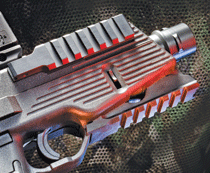 Shooting Impressions
Shooting Impressions
Strictly “as issued” in civilian-legal guise, the Brugger & Thomet MP9 is just a big, clunky pistol. The gun is marginally helped with a properly fitted sling acting as a “soft” stock. However, the MP9 becomes a much more useful tool when fitted with a short forward grip like TangoDown’s stubby BattleGrip or B&T’s own shoulder stock.
Be warned, however, that adding either a forward vertical grip or a shoulder stock will render the MP9 in violation of federal law and open up a 55 gallon drum of BATFE trouble. The MP9 remains in its most viable form as a Class III weapon.
That said, the MP9 comes into its own as a PDW with a snug sling and a vertical grip. I like the TangoDown stubby BattleGrip. Adjusting the sling to pull tight as your arms extend into a firing grip is amazingly steady as one hand holds the pistol grip and the other the stubby. With three points of contact—the pistol grip, a forward grip and the strap—the MP9 holds as steady as a rifle, almost.
Rapid fire was easily controlled and although we didn’t have a full-auto version to test, we can slap a trigger fast enough to see there was virtually no muzzle jump from the three-point grip and the soft-shooting mechanism of the gun. Believe me, you don’t want to be within 50 yards of a hard-nosed Secret Service agent with one of these under his Brooks Brothers blazers.
The MP9 comes with either a flush-fitting 15 round magazine or an extended 30-rounder, both of which are made of a transparent, see-through plastic. Some magazines are more transparent that others. We received a couple that were smoky and not so easy to see into and a couple that were as clear as a windshield.
Informal accuracy testing with a mix of ball and hollowpoint 9mm ammo produced 25 yard groups in the 1″ to 2″ range, better than most service grade 9mm pistols and much easier to shoot well with the sling taut and two grips. A European tester told us that he fired 6,000 rounds without a malfunction on a rock’n’rock MP9 before he ran out of ammo. We had no jams either, but with considerably less rounds fired.
We tried two optics on the MP9, Aimpoint’s new T1 micro red dot and Trijicon’s reflex sight. We are unabashed fans of all things Trijicon, but in this case, the new little Aimpoint was just unbeatable. It fit the MP9 perfectly and the red dot was fast and easy to pick up. The Trijicon reflex is a great sight but for this gun, the Aimpoint T1 is the way to go.
Brugger & Thomet has an exclusive importer in the United States by the name of DS Arms. DSA tells me that a .45 ACP version of the MP9 (presumably the MP45) is in the final stages of testing in Switzerland. I would assume magazine capacity will be 10 and 20 rounds instead of 15 and 30, but that’s a guess.
What isn’t conjecture is that Brugger & Thomet has picked up a solid design from Steyr and made it better. The tactical role for a PDW may be limited, but the genre remains interesting and the MP9 deserves a place in any serious tactical collection.
